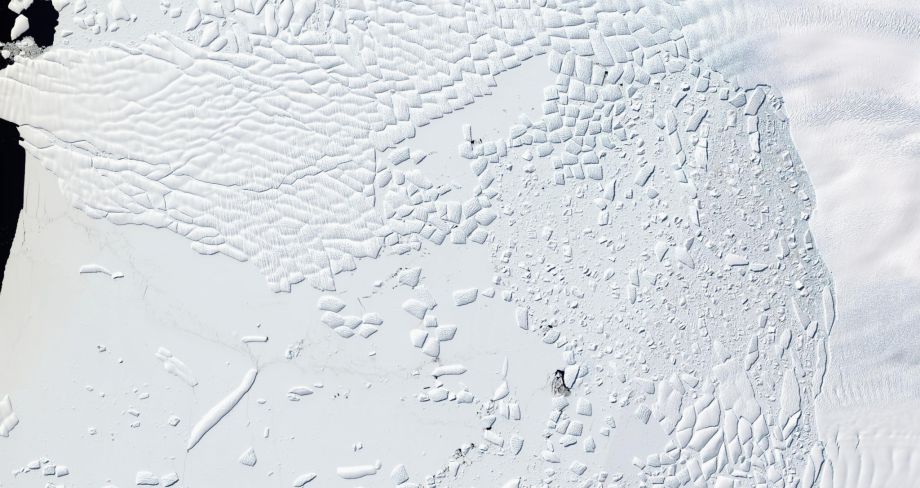Scientists model a new mechanism of climate doom
Published 3:44 pm, Wednesday, March 30, 2016

This satellite image provided by Nature/Knut Christianson, taken Jan. 9, 2016, shows the Thwaites Glacier and its ice cliff at the terminus of Thwaites Glacier, West Antarctica. A new study points says ice cliffs may lead to faster melting of Antarctic ice sheets and more sea level rise than previously thought with the Thwaites Glacier and its ice cliffs as the most likely place for this process to start. (Knut Christianson/Nature via AP)
Puzzled by evidence of fast and high sea level rise in Earth's deep history, a climate scientist at Penn State rejiggered the data going into his (and his team's) future climate models and finally found a combination of influences that show a dramatic increase in speed and height (depth?) of future seas.
Sounds phony when written like that, but it's actually a very sound way for getting closer to the truth of just how much ocean humans are going to have to deal with and by when.
The Greenland Ice Sheet is already pretty much scheduled to dump its icy water into the sea, but that significant contribution to the future of human suffering pales in comparison to what will be visited upon future generations if the Antarctic ice slips off its rocky perch.
From Penn State News:
Antarctica was the primary contributor to sea level rise in the past and may be the primary contributor in the future because much of its ice sits on ground. Floating ice, like that of the Arctic Ocean, is already in the water and if it melts, does not raise sea level. The Antarctic contribution will also probably dominate melt from the smaller Greenland Ice Sheet. While only parts of Antarctica will melt in the worst case scenario, the melting suggested by the model would be sufficient to double the recent estimates by the Intergovernmental Panel on Climate Change for future sea-level rise over the next 100 years.
"Recently we looked at the long-standing problem posed by geological evidence that suggests sea level rose dramatically in the past, possibly up to 10 to 20 meters around 3 million years ago in the Pliocene," said David Pollard, senior scientist in Earth and Environmental Systems Institute, Penn State. "Existing models couldn't simulate enough ice sheet melting to explain that."
So, they just made up some stuff so their model would work for the worst-case scenario right?
Not exactly. The scientists looked at known and observable mechanisms at play in the Antarctic: infiltration of melt-water and rain deep into the ice sheet and also at the physics of how high a cliff of exposed ice could get before it starts to sheer off as the glaciers retreat upland. So, the team used ...
"... a model coupling ice sheet and climate dynamics—including previously underappreciated processes linking atmospheric warming with hydrofracturing of buttressing ice shelves and structural collapse of marine-terminating ice cliffs — that is calibrated against Pliocene and Last Interglacial sea-level estimates and applied to future greenhouse gas emission scenarios," the researchers wrote in their study "Contribution of Antarctica to past and future sea-level rise" published Wednesday in Nature.
Punchline from the study:
"Antarctica has the potential to contribute more than a metre of sea-level rise by 2100 and more than 15 metres by 2500, if emissions continue unabated. In this case atmospheric warming will soon become the dominant driver of ice loss, but prolonged ocean warming will delay its recovery for thousands of years."
Note, that's roughly three feet of sea level rise within the lives of children born today. As the NY Times adds it up:
"With ice melting in other regions, too, the total rise of the sea could reach five or six feet by 2100, the researchers found. That is roughly twice the increase reported as a plausible worst-case scenario by a United Nations panel just three years ago, and so high it would likely provoke a profound crisis within the lifetimes of children being born today."
Yeah, but, it's just math combined with political desire to make scientists rich, right?
"Although the future sea-level contribution in our model is greater than previously thought, it is based on credible mechanisms and is consistent with geologic evidence of past sea-level rise," said Pollard in the Penn news release. "We regard the results as worst-case envelopes of possible future behavior, and the mechanisms should be considered seriously in future work."
Okay, based on data and science collected over decades by hundreds of scientists, we're facing trouble, but it's the "worst-case." So, we should be alright! You know, how often does the worst-case scenario actually play out ... besides the roughly dozen mass extinctions that have plagued the Earth before now?
In a review of the study written in Nature on Wednesday as well, science writer Jeff Tollegson wrote:
Glaciologists are already aware of the destructive power of the atmospheric-warming and cliff-collapse mechanisms that DeConto and Pollard's model simulates. A string of unusually warm summers caused the sudden collapse of Antarctica's Larsen B ice shelf in 2002. And scientists have witnessed the basic physics of ice-cliff collapse during calving events on the Jakobshavn and Helheim glaciers in Greenland.
"On the observational side, I see the things they are talking about," says David Holland, a physical-climate scientist at New York University. "There's a lot of observation and modeling to go, but they are adjusting people's thinking in a very scientific way."
And unfortunately, we are currently on the worst-case-scenario path of increasing global temperature well beyond 2 degrees Celsius (considered the baseline for devastating climate warming) and there's very little evidence we'll do anything to land our climate-changing economy at anything near 2 degrees celsius.
We've been warned ... again ...
Jake Ellison can be reached at 206-448-8334 or jakeellison@seattlepi.com. Follow Jake on Twitter at twitter.com/Jake_News. Also, swing by and *LIKE* his page on Facebook. If Google Plus is your thing, check out our science coverage here.